Restorative Justice: Analysis of a Juvenile Crime Case Study
VerifiedAdded on 2022/09/25
|14
|3091
|32
Report
AI Summary
This report presents a comprehensive analysis of a restorative justice case study involving a 15-year-old male, Joseph, who committed several fraud and property offenses. The analysis begins with an introduction to restorative justice, highlighting its focus on repairing harm and addressing the root causes of crime. A detailed conflict diagram illustrates the offender, victims, and community members involved. The report then describes the approaches used, particularly the transformative restorative approach, and analyzes the justice processes, including a restorative justice evaluation matrix. Recommendations are provided, including an action plan for restorative justice. The case study examines the offender's background, offenses, court proceedings, and the positive outcomes achieved through counseling and community service. The report also includes a discussion of key concepts such as inclusion, amends, reintegration, and human rights considerations. References from various sources are included to support the analysis.
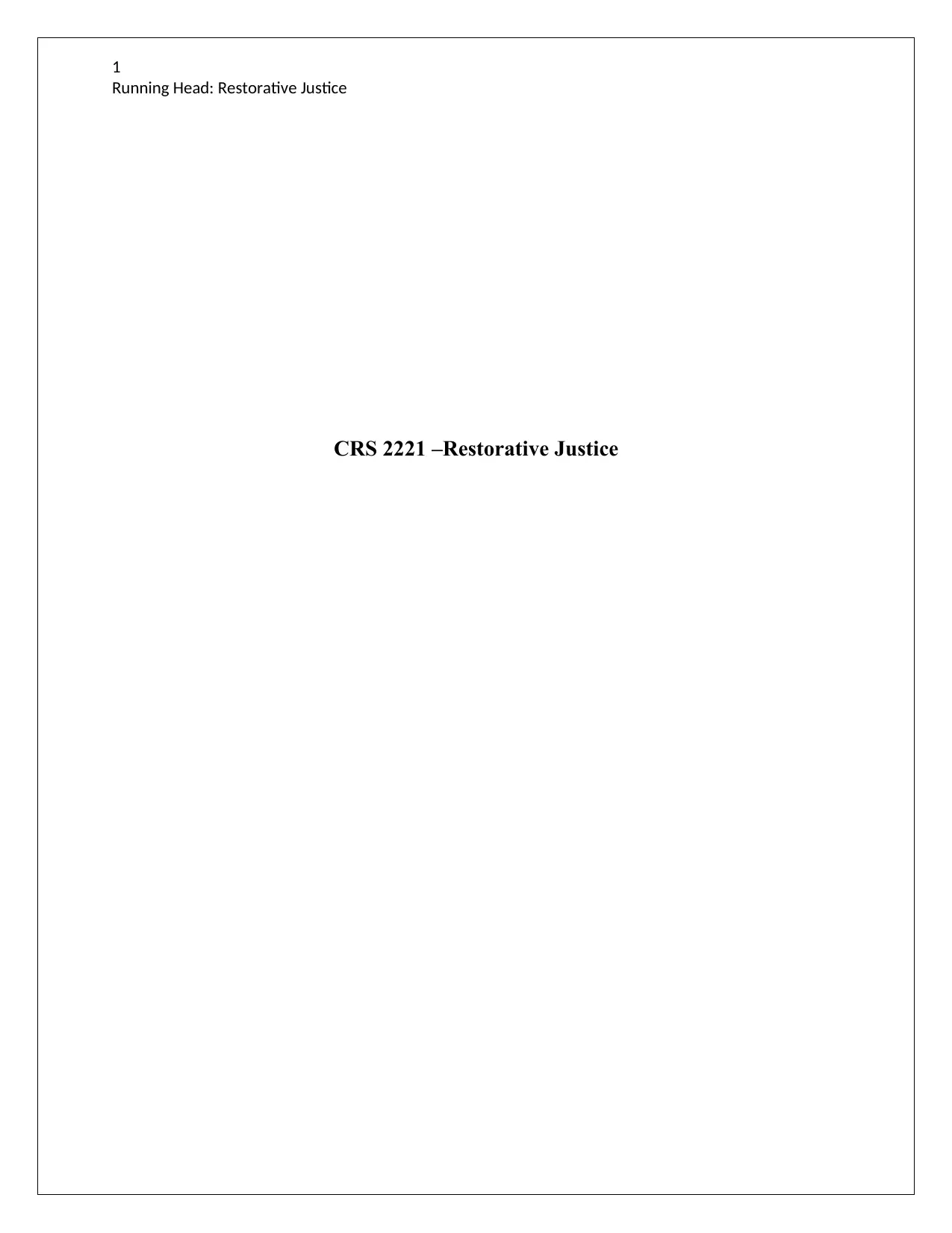
1
Running Head: Restorative Justice
CRS 2221 –Restorative Justice
Running Head: Restorative Justice
CRS 2221 –Restorative Justice
Paraphrase This Document
Need a fresh take? Get an instant paraphrase of this document with our AI Paraphraser
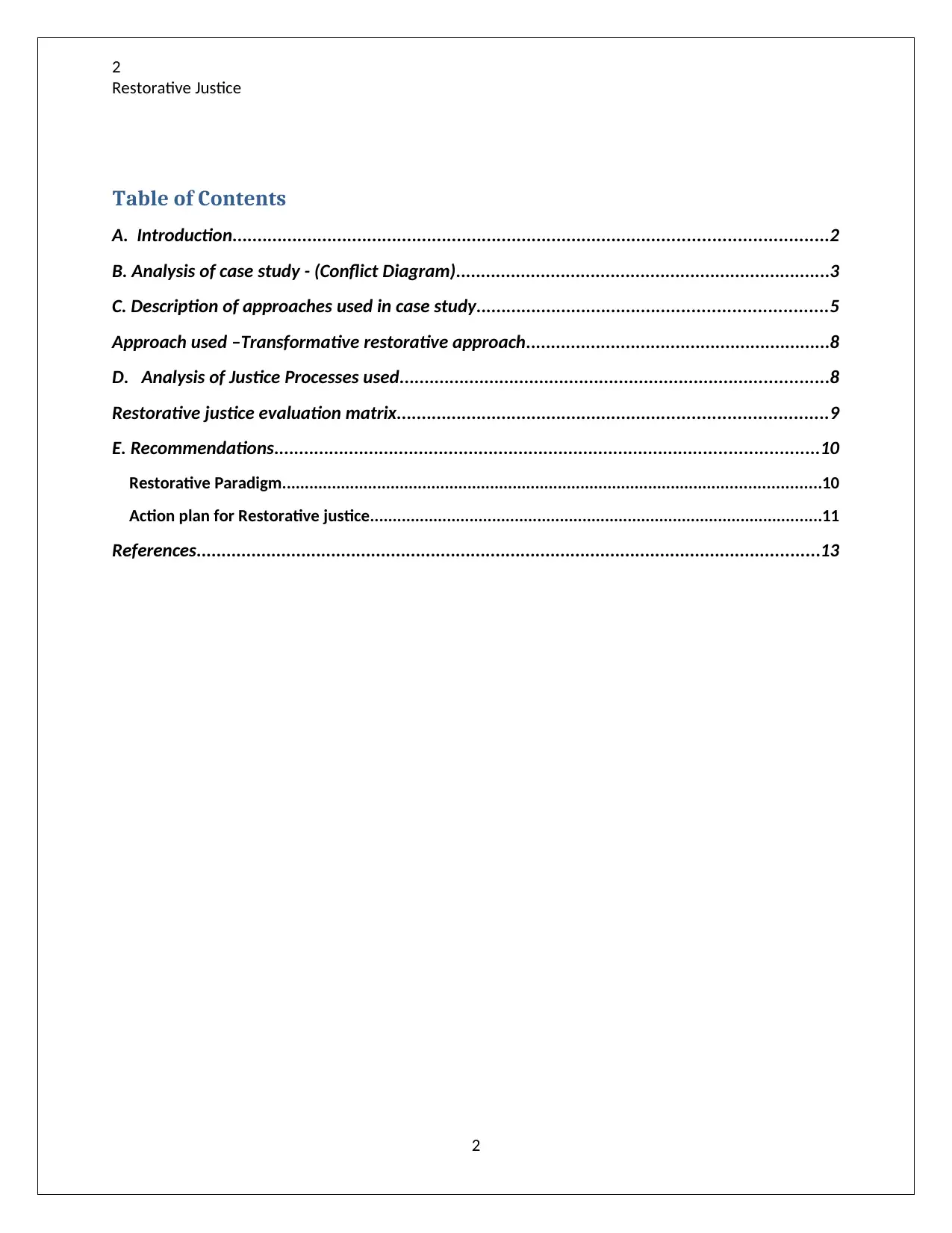
2
Restorative Justice
Table of Contents
A. Introduction.......................................................................................................................2
B. Analysis of case study - (Conflict Diagram)...........................................................................3
C. Description of approaches used in case study......................................................................5
Approach used –Transformative restorative approach.............................................................8
D. Analysis of Justice Processes used......................................................................................8
Restorative justice evaluation matrix......................................................................................9
E. Recommendations.............................................................................................................10
Restorative Paradigm.......................................................................................................................10
Action plan for Restorative justice....................................................................................................11
References.............................................................................................................................13
2
Restorative Justice
Table of Contents
A. Introduction.......................................................................................................................2
B. Analysis of case study - (Conflict Diagram)...........................................................................3
C. Description of approaches used in case study......................................................................5
Approach used –Transformative restorative approach.............................................................8
D. Analysis of Justice Processes used......................................................................................8
Restorative justice evaluation matrix......................................................................................9
E. Recommendations.............................................................................................................10
Restorative Paradigm.......................................................................................................................10
Action plan for Restorative justice....................................................................................................11
References.............................................................................................................................13
2
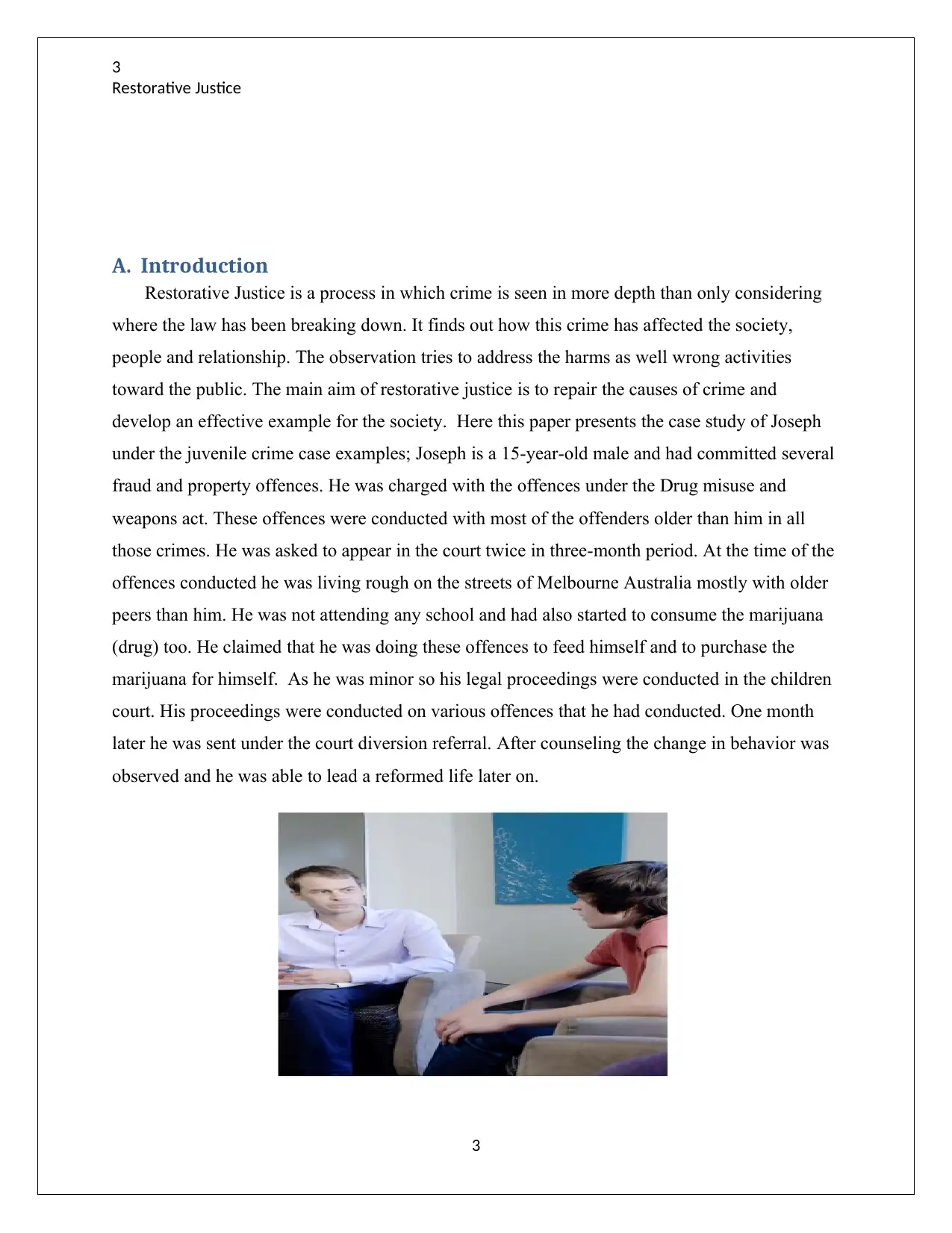
3
Restorative Justice
A. Introduction
Restorative Justice is a process in which crime is seen in more depth than only considering
where the law has been breaking down. It finds out how this crime has affected the society,
people and relationship. The observation tries to address the harms as well wrong activities
toward the public. The main aim of restorative justice is to repair the causes of crime and
develop an effective example for the society. Here this paper presents the case study of Joseph
under the juvenile crime case examples; Joseph is a 15-year-old male and had committed several
fraud and property offences. He was charged with the offences under the Drug misuse and
weapons act. These offences were conducted with most of the offenders older than him in all
those crimes. He was asked to appear in the court twice in three-month period. At the time of the
offences conducted he was living rough on the streets of Melbourne Australia mostly with older
peers than him. He was not attending any school and had also started to consume the marijuana
(drug) too. He claimed that he was doing these offences to feed himself and to purchase the
marijuana for himself. As he was minor so his legal proceedings were conducted in the children
court. His proceedings were conducted on various offences that he had conducted. One month
later he was sent under the court diversion referral. After counseling the change in behavior was
observed and he was able to lead a reformed life later on.
3
Restorative Justice
A. Introduction
Restorative Justice is a process in which crime is seen in more depth than only considering
where the law has been breaking down. It finds out how this crime has affected the society,
people and relationship. The observation tries to address the harms as well wrong activities
toward the public. The main aim of restorative justice is to repair the causes of crime and
develop an effective example for the society. Here this paper presents the case study of Joseph
under the juvenile crime case examples; Joseph is a 15-year-old male and had committed several
fraud and property offences. He was charged with the offences under the Drug misuse and
weapons act. These offences were conducted with most of the offenders older than him in all
those crimes. He was asked to appear in the court twice in three-month period. At the time of the
offences conducted he was living rough on the streets of Melbourne Australia mostly with older
peers than him. He was not attending any school and had also started to consume the marijuana
(drug) too. He claimed that he was doing these offences to feed himself and to purchase the
marijuana for himself. As he was minor so his legal proceedings were conducted in the children
court. His proceedings were conducted on various offences that he had conducted. One month
later he was sent under the court diversion referral. After counseling the change in behavior was
observed and he was able to lead a reformed life later on.
3
⊘ This is a preview!⊘
Do you want full access?
Subscribe today to unlock all pages.

Trusted by 1+ million students worldwide
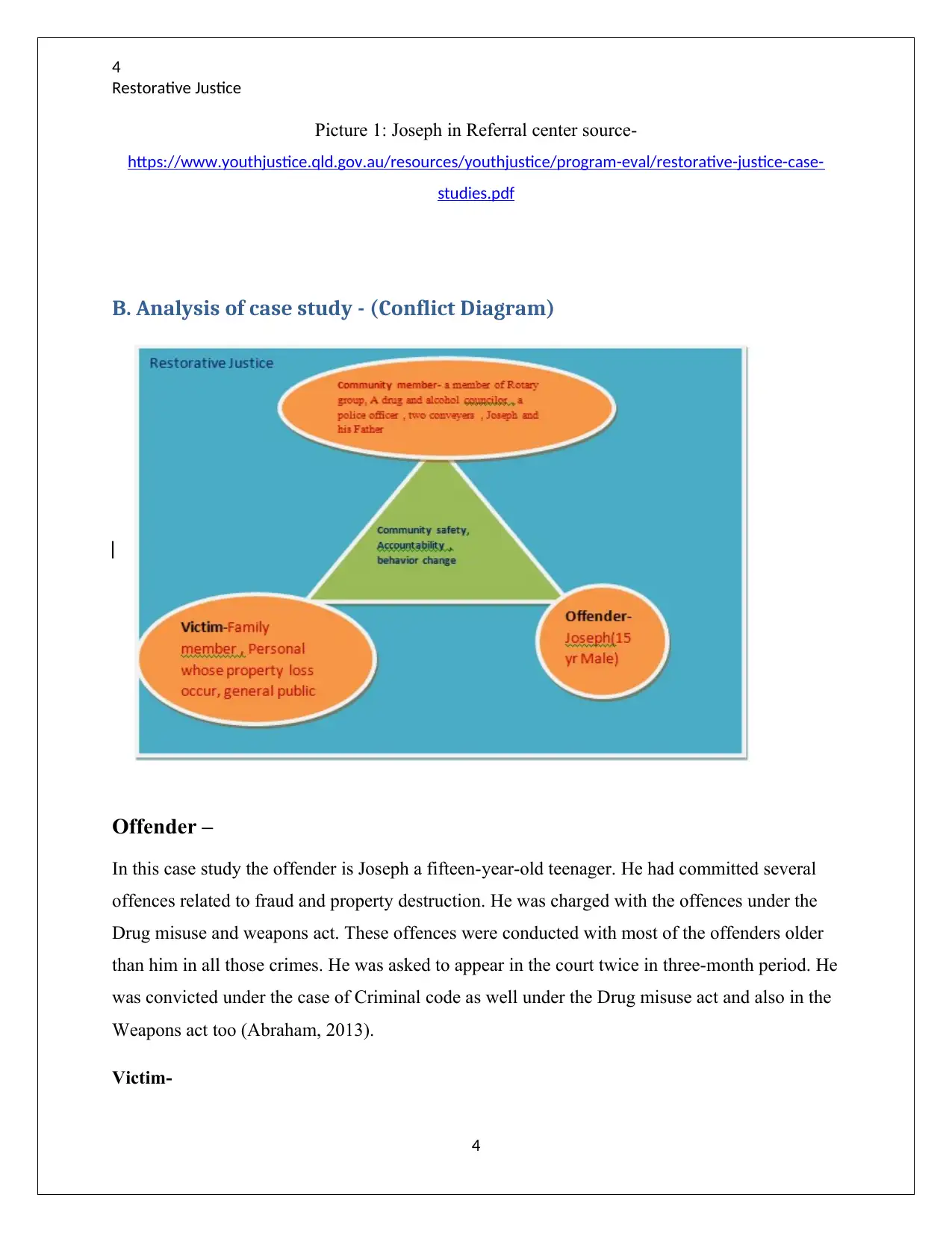
4
Restorative Justice
Picture 1: Joseph in Referral center source-
https://www.youthjustice.qld.gov.au/resources/youthjustice/program-eval/restorative-justice-case-
studies.pdf
B. Analysis of case study - (Conflict Diagram)
Offender –
In this case study the offender is Joseph a fifteen-year-old teenager. He had committed several
offences related to fraud and property destruction. He was charged with the offences under the
Drug misuse and weapons act. These offences were conducted with most of the offenders older
than him in all those crimes. He was asked to appear in the court twice in three-month period. He
was convicted under the case of Criminal code as well under the Drug misuse act and also in the
Weapons act too (Abraham, 2013).
Victim-
4
Restorative Justice
Picture 1: Joseph in Referral center source-
https://www.youthjustice.qld.gov.au/resources/youthjustice/program-eval/restorative-justice-case-
studies.pdf
B. Analysis of case study - (Conflict Diagram)
Offender –
In this case study the offender is Joseph a fifteen-year-old teenager. He had committed several
offences related to fraud and property destruction. He was charged with the offences under the
Drug misuse and weapons act. These offences were conducted with most of the offenders older
than him in all those crimes. He was asked to appear in the court twice in three-month period. He
was convicted under the case of Criminal code as well under the Drug misuse act and also in the
Weapons act too (Abraham, 2013).
Victim-
4
Paraphrase This Document
Need a fresh take? Get an instant paraphrase of this document with our AI Paraphraser
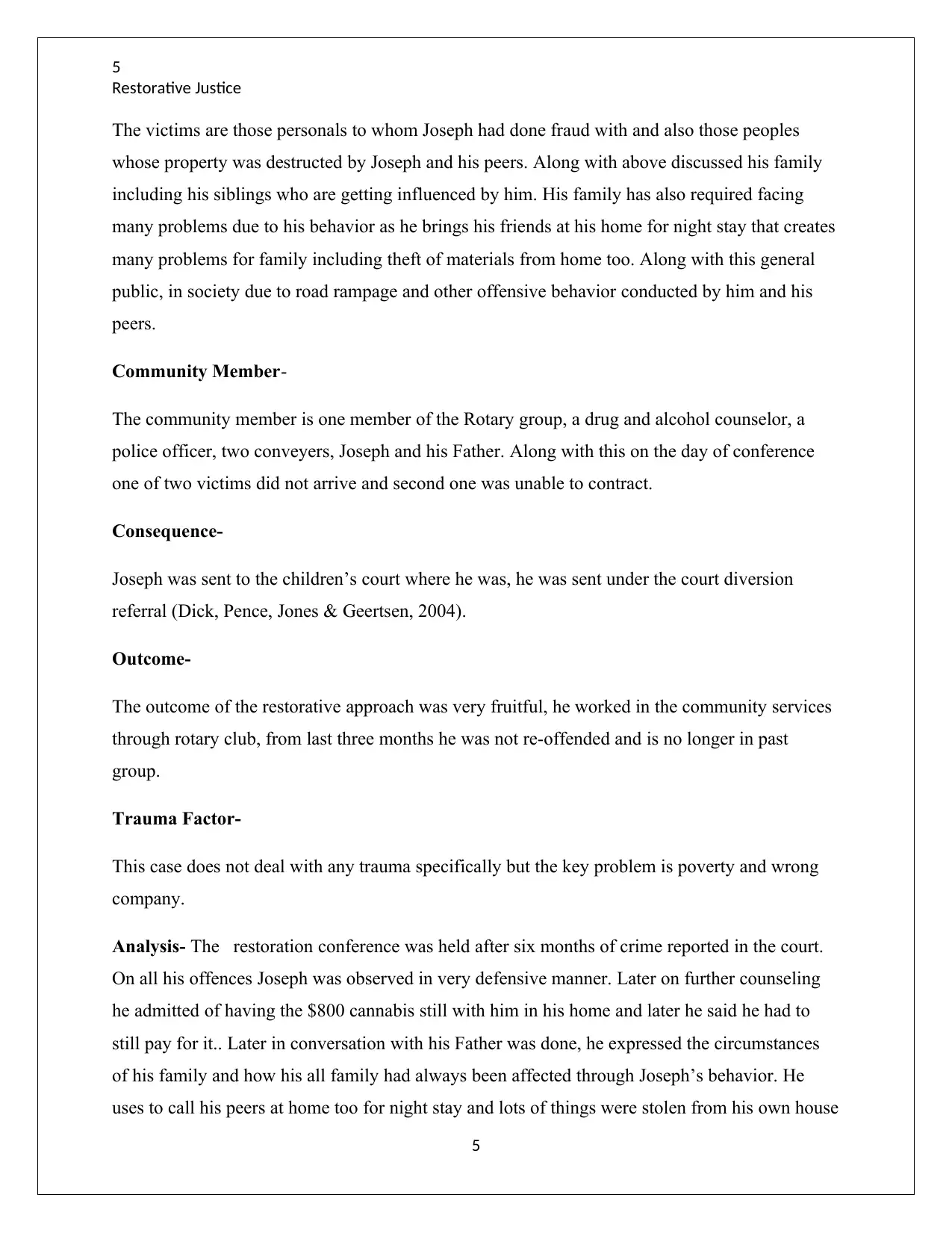
5
Restorative Justice
The victims are those personals to whom Joseph had done fraud with and also those peoples
whose property was destructed by Joseph and his peers. Along with above discussed his family
including his siblings who are getting influenced by him. His family has also required facing
many problems due to his behavior as he brings his friends at his home for night stay that creates
many problems for family including theft of materials from home too. Along with this general
public, in society due to road rampage and other offensive behavior conducted by him and his
peers.
Community Member-
The community member is one member of the Rotary group, a drug and alcohol counselor, a
police officer, two conveyers, Joseph and his Father. Along with this on the day of conference
one of two victims did not arrive and second one was unable to contract.
Consequence-
Joseph was sent to the children’s court where he was, he was sent under the court diversion
referral (Dick, Pence, Jones & Geertsen, 2004).
Outcome-
The outcome of the restorative approach was very fruitful, he worked in the community services
through rotary club, from last three months he was not re-offended and is no longer in past
group.
Trauma Factor-
This case does not deal with any trauma specifically but the key problem is poverty and wrong
company.
Analysis- The restoration conference was held after six months of crime reported in the court.
On all his offences Joseph was observed in very defensive manner. Later on further counseling
he admitted of having the $800 cannabis still with him in his home and later he said he had to
still pay for it.. Later in conversation with his Father was done, he expressed the circumstances
of his family and how his all family had always been affected through Joseph’s behavior. He
uses to call his peers at home too for night stay and lots of things were stolen from his own house
5
Restorative Justice
The victims are those personals to whom Joseph had done fraud with and also those peoples
whose property was destructed by Joseph and his peers. Along with above discussed his family
including his siblings who are getting influenced by him. His family has also required facing
many problems due to his behavior as he brings his friends at his home for night stay that creates
many problems for family including theft of materials from home too. Along with this general
public, in society due to road rampage and other offensive behavior conducted by him and his
peers.
Community Member-
The community member is one member of the Rotary group, a drug and alcohol counselor, a
police officer, two conveyers, Joseph and his Father. Along with this on the day of conference
one of two victims did not arrive and second one was unable to contract.
Consequence-
Joseph was sent to the children’s court where he was, he was sent under the court diversion
referral (Dick, Pence, Jones & Geertsen, 2004).
Outcome-
The outcome of the restorative approach was very fruitful, he worked in the community services
through rotary club, from last three months he was not re-offended and is no longer in past
group.
Trauma Factor-
This case does not deal with any trauma specifically but the key problem is poverty and wrong
company.
Analysis- The restoration conference was held after six months of crime reported in the court.
On all his offences Joseph was observed in very defensive manner. Later on further counseling
he admitted of having the $800 cannabis still with him in his home and later he said he had to
still pay for it.. Later in conversation with his Father was done, he expressed the circumstances
of his family and how his all family had always been affected through Joseph’s behavior. He
uses to call his peers at home too for night stay and lots of things were stolen from his own house
5
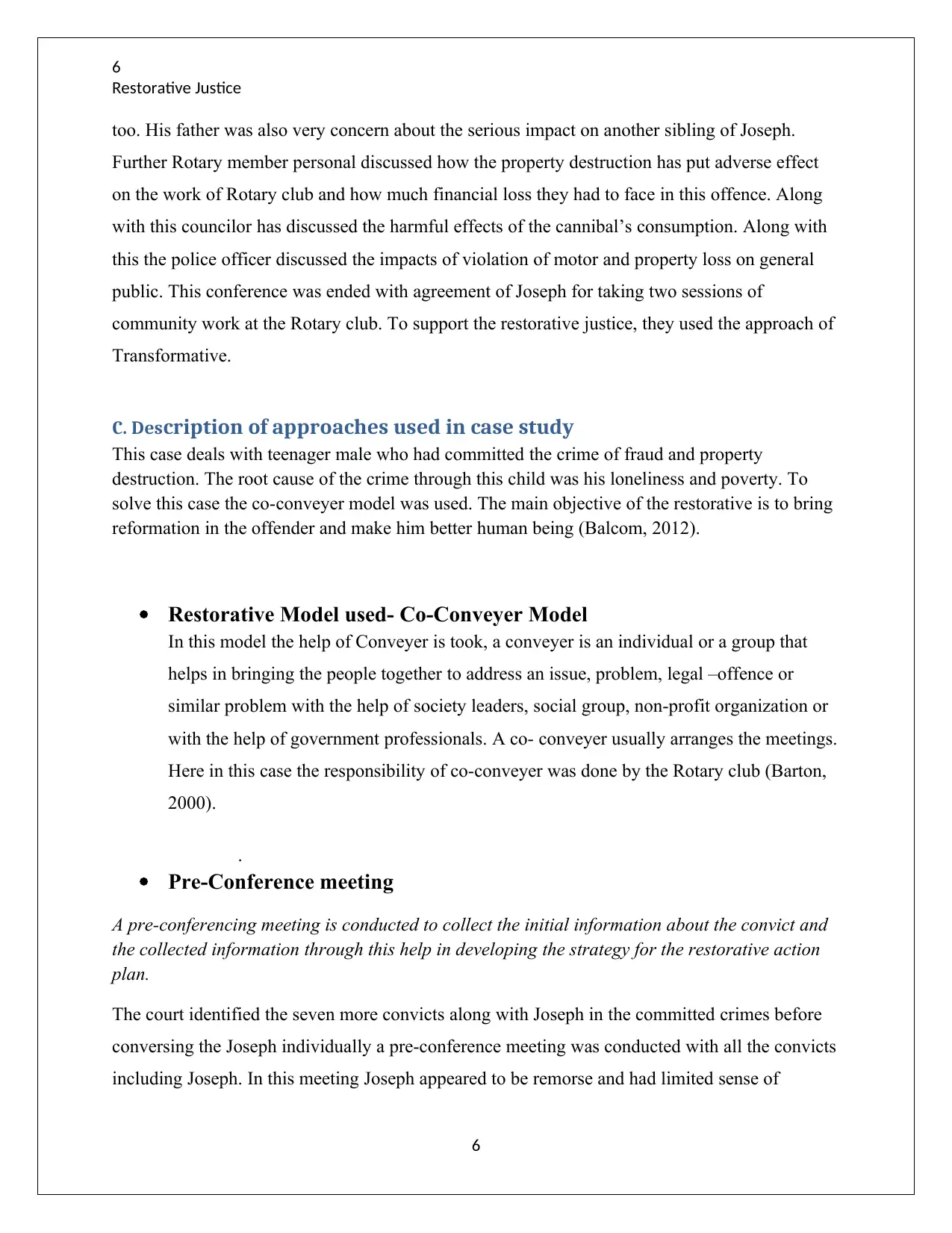
6
Restorative Justice
too. His father was also very concern about the serious impact on another sibling of Joseph.
Further Rotary member personal discussed how the property destruction has put adverse effect
on the work of Rotary club and how much financial loss they had to face in this offence. Along
with this councilor has discussed the harmful effects of the cannibal’s consumption. Along with
this the police officer discussed the impacts of violation of motor and property loss on general
public. This conference was ended with agreement of Joseph for taking two sessions of
community work at the Rotary club. To support the restorative justice, they used the approach of
Transformative.
C. Description of approaches used in case study
This case deals with teenager male who had committed the crime of fraud and property
destruction. The root cause of the crime through this child was his loneliness and poverty. To
solve this case the co-conveyer model was used. The main objective of the restorative is to bring
reformation in the offender and make him better human being (Balcom, 2012).
Restorative Model used- Co-Conveyer Model
In this model the help of Conveyer is took, a conveyer is an individual or a group that
helps in bringing the people together to address an issue, problem, legal –offence or
similar problem with the help of society leaders, social group, non-profit organization or
with the help of government professionals. A co- conveyer usually arranges the meetings.
Here in this case the responsibility of co-conveyer was done by the Rotary club (Barton,
2000).
.
Pre-Conference meeting
A pre-conferencing meeting is conducted to collect the initial information about the convict and
the collected information through this help in developing the strategy for the restorative action
plan.
The court identified the seven more convicts along with Joseph in the committed crimes before
conversing the Joseph individually a pre-conference meeting was conducted with all the convicts
including Joseph. In this meeting Joseph appeared to be remorse and had limited sense of
6
Restorative Justice
too. His father was also very concern about the serious impact on another sibling of Joseph.
Further Rotary member personal discussed how the property destruction has put adverse effect
on the work of Rotary club and how much financial loss they had to face in this offence. Along
with this councilor has discussed the harmful effects of the cannibal’s consumption. Along with
this the police officer discussed the impacts of violation of motor and property loss on general
public. This conference was ended with agreement of Joseph for taking two sessions of
community work at the Rotary club. To support the restorative justice, they used the approach of
Transformative.
C. Description of approaches used in case study
This case deals with teenager male who had committed the crime of fraud and property
destruction. The root cause of the crime through this child was his loneliness and poverty. To
solve this case the co-conveyer model was used. The main objective of the restorative is to bring
reformation in the offender and make him better human being (Balcom, 2012).
Restorative Model used- Co-Conveyer Model
In this model the help of Conveyer is took, a conveyer is an individual or a group that
helps in bringing the people together to address an issue, problem, legal –offence or
similar problem with the help of society leaders, social group, non-profit organization or
with the help of government professionals. A co- conveyer usually arranges the meetings.
Here in this case the responsibility of co-conveyer was done by the Rotary club (Barton,
2000).
.
Pre-Conference meeting
A pre-conferencing meeting is conducted to collect the initial information about the convict and
the collected information through this help in developing the strategy for the restorative action
plan.
The court identified the seven more convicts along with Joseph in the committed crimes before
conversing the Joseph individually a pre-conference meeting was conducted with all the convicts
including Joseph. In this meeting Joseph appeared to be remorse and had limited sense of
6
⊘ This is a preview!⊘
Do you want full access?
Subscribe today to unlock all pages.

Trusted by 1+ million students worldwide
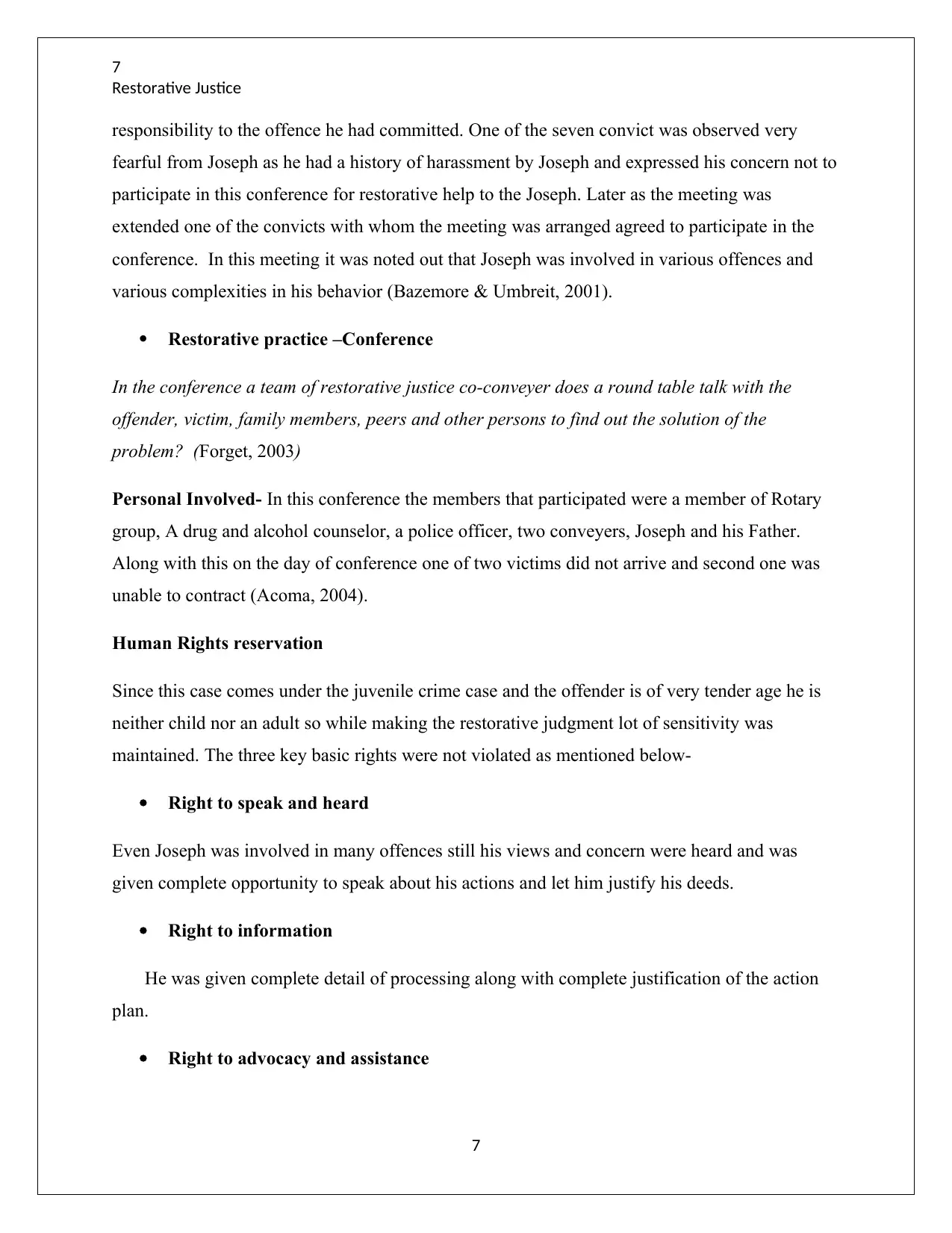
7
Restorative Justice
responsibility to the offence he had committed. One of the seven convict was observed very
fearful from Joseph as he had a history of harassment by Joseph and expressed his concern not to
participate in this conference for restorative help to the Joseph. Later as the meeting was
extended one of the convicts with whom the meeting was arranged agreed to participate in the
conference. In this meeting it was noted out that Joseph was involved in various offences and
various complexities in his behavior (Bazemore & Umbreit, 2001).
Restorative practice –Conference
In the conference a team of restorative justice co-conveyer does a round table talk with the
offender, victim, family members, peers and other persons to find out the solution of the
problem? (Forget, 2003)
Personal Involved- In this conference the members that participated were a member of Rotary
group, A drug and alcohol counselor, a police officer, two conveyers, Joseph and his Father.
Along with this on the day of conference one of two victims did not arrive and second one was
unable to contract (Acoma, 2004).
Human Rights reservation
Since this case comes under the juvenile crime case and the offender is of very tender age he is
neither child nor an adult so while making the restorative judgment lot of sensitivity was
maintained. The three key basic rights were not violated as mentioned below-
Right to speak and heard
Even Joseph was involved in many offences still his views and concern were heard and was
given complete opportunity to speak about his actions and let him justify his deeds.
Right to information
He was given complete detail of processing along with complete justification of the action
plan.
Right to advocacy and assistance
7
Restorative Justice
responsibility to the offence he had committed. One of the seven convict was observed very
fearful from Joseph as he had a history of harassment by Joseph and expressed his concern not to
participate in this conference for restorative help to the Joseph. Later as the meeting was
extended one of the convicts with whom the meeting was arranged agreed to participate in the
conference. In this meeting it was noted out that Joseph was involved in various offences and
various complexities in his behavior (Bazemore & Umbreit, 2001).
Restorative practice –Conference
In the conference a team of restorative justice co-conveyer does a round table talk with the
offender, victim, family members, peers and other persons to find out the solution of the
problem? (Forget, 2003)
Personal Involved- In this conference the members that participated were a member of Rotary
group, A drug and alcohol counselor, a police officer, two conveyers, Joseph and his Father.
Along with this on the day of conference one of two victims did not arrive and second one was
unable to contract (Acoma, 2004).
Human Rights reservation
Since this case comes under the juvenile crime case and the offender is of very tender age he is
neither child nor an adult so while making the restorative judgment lot of sensitivity was
maintained. The three key basic rights were not violated as mentioned below-
Right to speak and heard
Even Joseph was involved in many offences still his views and concern were heard and was
given complete opportunity to speak about his actions and let him justify his deeds.
Right to information
He was given complete detail of processing along with complete justification of the action
plan.
Right to advocacy and assistance
7
Paraphrase This Document
Need a fresh take? Get an instant paraphrase of this document with our AI Paraphraser
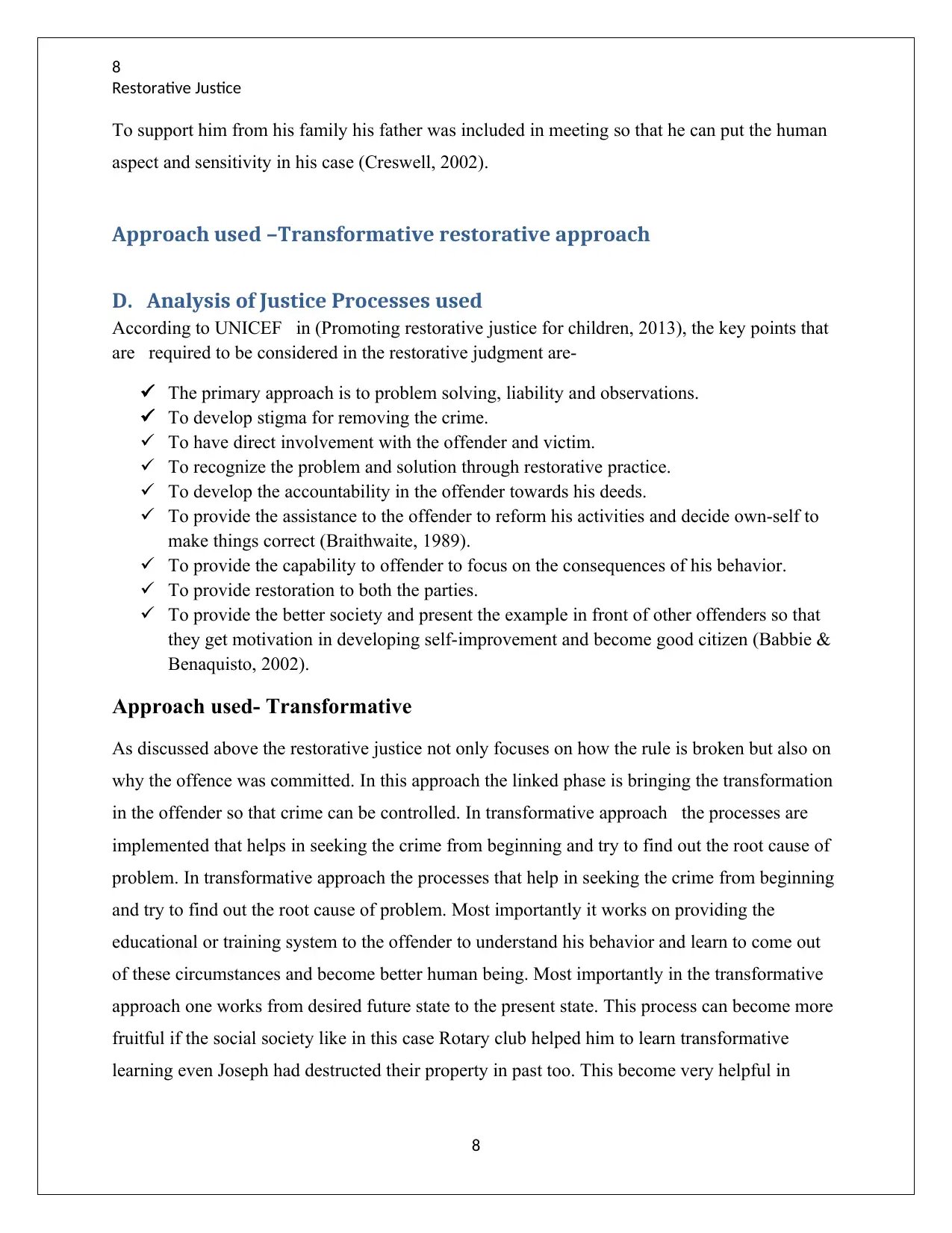
8
Restorative Justice
To support him from his family his father was included in meeting so that he can put the human
aspect and sensitivity in his case (Creswell, 2002).
Approach used –Transformative restorative approach
D. Analysis of Justice Processes used
According to UNICEF in (Promoting restorative justice for children, 2013), the key points that
are required to be considered in the restorative judgment are-
The primary approach is to problem solving, liability and observations.
To develop stigma for removing the crime.
To have direct involvement with the offender and victim.
To recognize the problem and solution through restorative practice.
To develop the accountability in the offender towards his deeds.
To provide the assistance to the offender to reform his activities and decide own-self to
make things correct (Braithwaite, 1989).
To provide the capability to offender to focus on the consequences of his behavior.
To provide restoration to both the parties.
To provide the better society and present the example in front of other offenders so that
they get motivation in developing self-improvement and become good citizen (Babbie &
Benaquisto, 2002).
Approach used- Transformative
As discussed above the restorative justice not only focuses on how the rule is broken but also on
why the offence was committed. In this approach the linked phase is bringing the transformation
in the offender so that crime can be controlled. In transformative approach the processes are
implemented that helps in seeking the crime from beginning and try to find out the root cause of
problem. In transformative approach the processes that help in seeking the crime from beginning
and try to find out the root cause of problem. Most importantly it works on providing the
educational or training system to the offender to understand his behavior and learn to come out
of these circumstances and become better human being. Most importantly in the transformative
approach one works from desired future state to the present state. This process can become more
fruitful if the social society like in this case Rotary club helped him to learn transformative
learning even Joseph had destructed their property in past too. This become very helpful in
8
Restorative Justice
To support him from his family his father was included in meeting so that he can put the human
aspect and sensitivity in his case (Creswell, 2002).
Approach used –Transformative restorative approach
D. Analysis of Justice Processes used
According to UNICEF in (Promoting restorative justice for children, 2013), the key points that
are required to be considered in the restorative judgment are-
The primary approach is to problem solving, liability and observations.
To develop stigma for removing the crime.
To have direct involvement with the offender and victim.
To recognize the problem and solution through restorative practice.
To develop the accountability in the offender towards his deeds.
To provide the assistance to the offender to reform his activities and decide own-self to
make things correct (Braithwaite, 1989).
To provide the capability to offender to focus on the consequences of his behavior.
To provide restoration to both the parties.
To provide the better society and present the example in front of other offenders so that
they get motivation in developing self-improvement and become good citizen (Babbie &
Benaquisto, 2002).
Approach used- Transformative
As discussed above the restorative justice not only focuses on how the rule is broken but also on
why the offence was committed. In this approach the linked phase is bringing the transformation
in the offender so that crime can be controlled. In transformative approach the processes are
implemented that helps in seeking the crime from beginning and try to find out the root cause of
problem. In transformative approach the processes that help in seeking the crime from beginning
and try to find out the root cause of problem. Most importantly it works on providing the
educational or training system to the offender to understand his behavior and learn to come out
of these circumstances and become better human being. Most importantly in the transformative
approach one works from desired future state to the present state. This process can become more
fruitful if the social society like in this case Rotary club helped him to learn transformative
learning even Joseph had destructed their property in past too. This become very helpful in
8
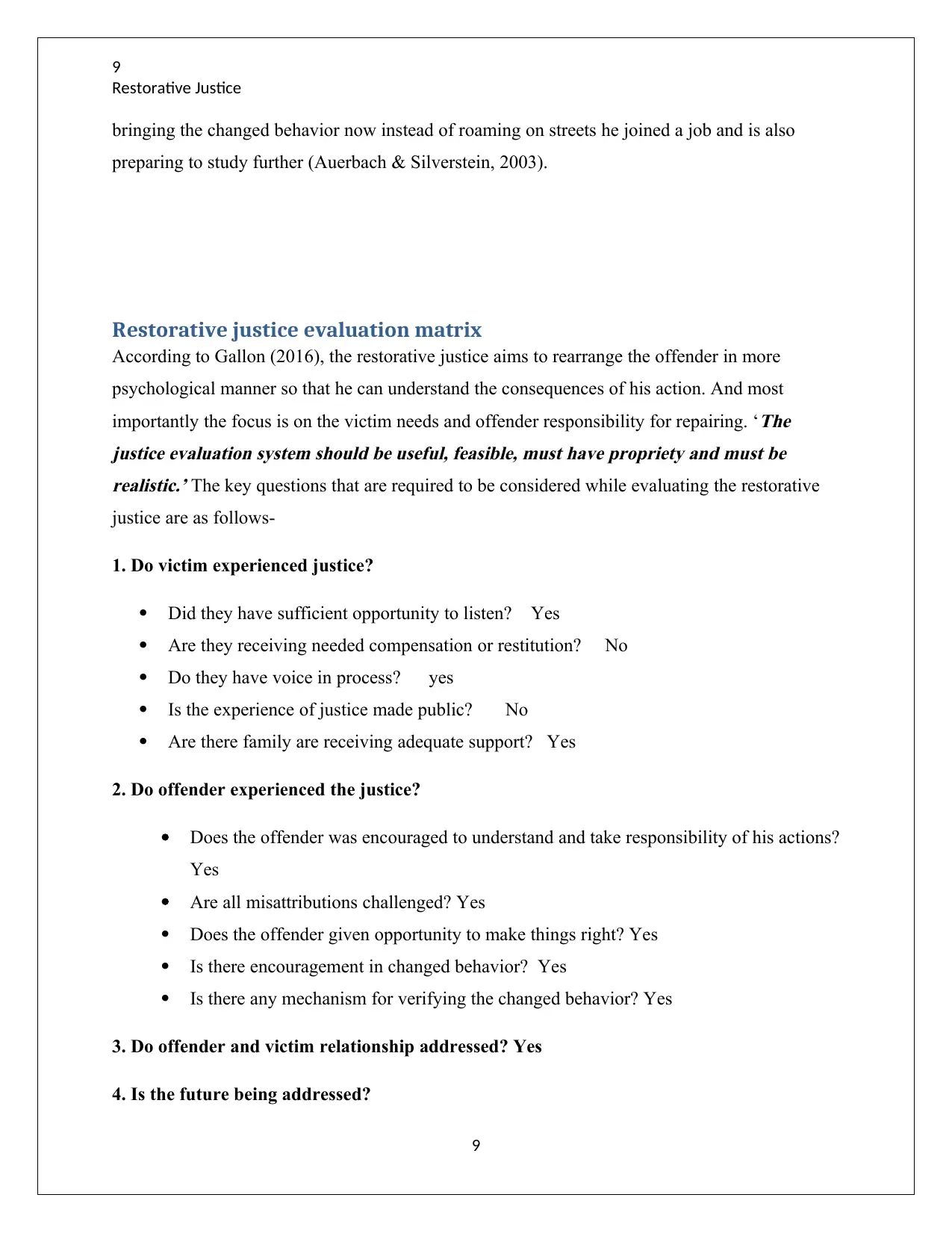
9
Restorative Justice
bringing the changed behavior now instead of roaming on streets he joined a job and is also
preparing to study further (Auerbach & Silverstein, 2003).
Restorative justice evaluation matrix
According to Gallon (2016), the restorative justice aims to rearrange the offender in more
psychological manner so that he can understand the consequences of his action. And most
importantly the focus is on the victim needs and offender responsibility for repairing. ‘
The
justice evaluation system should be useful, feasible, must have propriety and must be
realistic.’ The key questions that are required to be considered while evaluating the restorative
justice are as follows-
1. Do victim experienced justice?
Did they have sufficient opportunity to listen? Yes
Are they receiving needed compensation or restitution? No
Do they have voice in process? yes
Is the experience of justice made public? No
Are there family are receiving adequate support? Yes
2. Do offender experienced the justice?
Does the offender was encouraged to understand and take responsibility of his actions?
Yes
Are all misattributions challenged? Yes
Does the offender given opportunity to make things right? Yes
Is there encouragement in changed behavior? Yes
Is there any mechanism for verifying the changed behavior? Yes
3. Do offender and victim relationship addressed? Yes
4. Is the future being addressed?
9
Restorative Justice
bringing the changed behavior now instead of roaming on streets he joined a job and is also
preparing to study further (Auerbach & Silverstein, 2003).
Restorative justice evaluation matrix
According to Gallon (2016), the restorative justice aims to rearrange the offender in more
psychological manner so that he can understand the consequences of his action. And most
importantly the focus is on the victim needs and offender responsibility for repairing. ‘
The
justice evaluation system should be useful, feasible, must have propriety and must be
realistic.’ The key questions that are required to be considered while evaluating the restorative
justice are as follows-
1. Do victim experienced justice?
Did they have sufficient opportunity to listen? Yes
Are they receiving needed compensation or restitution? No
Do they have voice in process? yes
Is the experience of justice made public? No
Are there family are receiving adequate support? Yes
2. Do offender experienced the justice?
Does the offender was encouraged to understand and take responsibility of his actions?
Yes
Are all misattributions challenged? Yes
Does the offender given opportunity to make things right? Yes
Is there encouragement in changed behavior? Yes
Is there any mechanism for verifying the changed behavior? Yes
3. Do offender and victim relationship addressed? Yes
4. Is the future being addressed?
9
⊘ This is a preview!⊘
Do you want full access?
Subscribe today to unlock all pages.

Trusted by 1+ million students worldwide
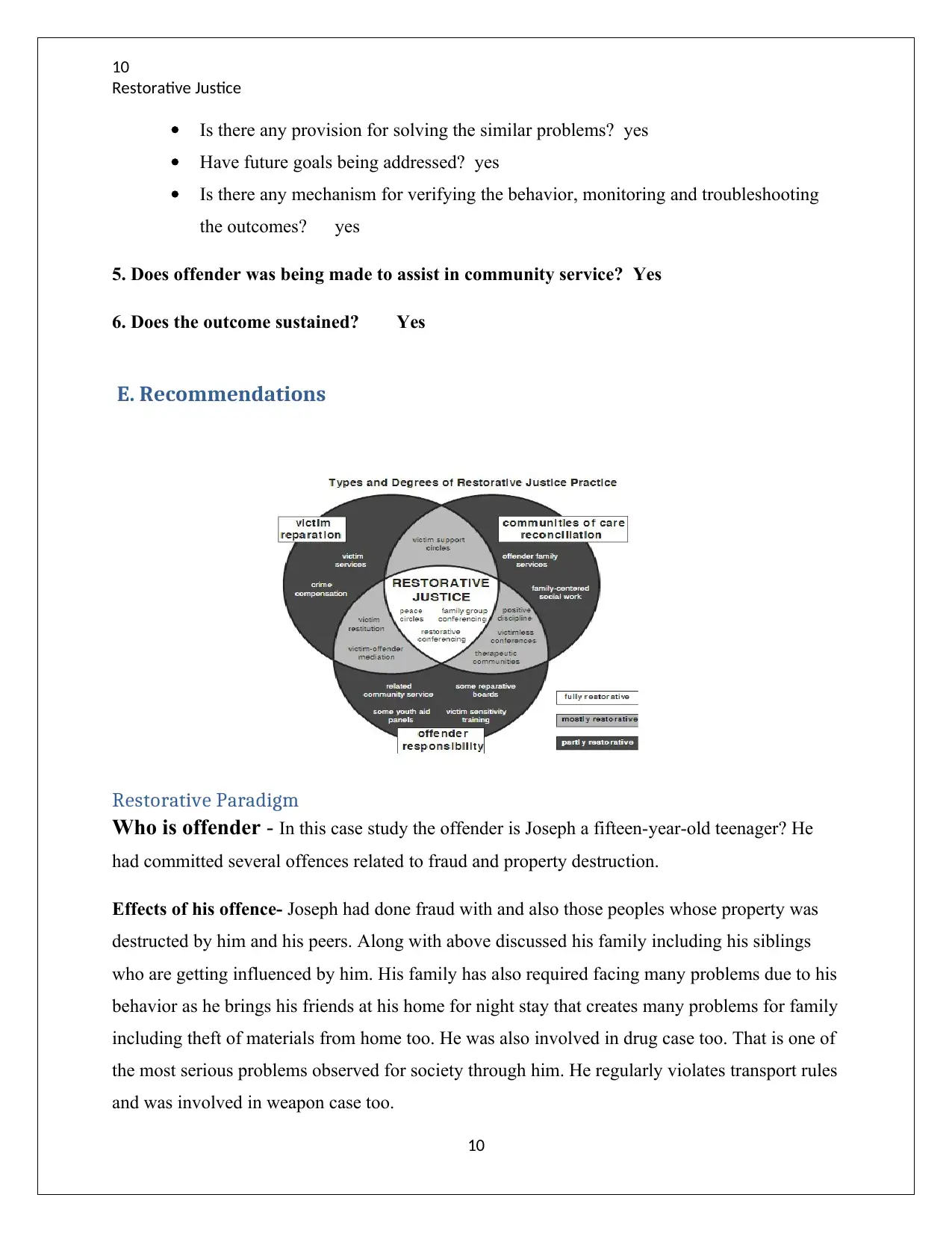
10
Restorative Justice
Is there any provision for solving the similar problems? yes
Have future goals being addressed? yes
Is there any mechanism for verifying the behavior, monitoring and troubleshooting
the outcomes? yes
5. Does offender was being made to assist in community service? Yes
6. Does the outcome sustained? Yes
E. Recommendations
Restorative Paradigm
Who is offender - In this case study the offender is Joseph a fifteen-year-old teenager? He
had committed several offences related to fraud and property destruction.
Effects of his offence- Joseph had done fraud with and also those peoples whose property was
destructed by him and his peers. Along with above discussed his family including his siblings
who are getting influenced by him. His family has also required facing many problems due to his
behavior as he brings his friends at his home for night stay that creates many problems for family
including theft of materials from home too. He was also involved in drug case too. That is one of
the most serious problems observed for society through him. He regularly violates transport rules
and was involved in weapon case too.
10
Restorative Justice
Is there any provision for solving the similar problems? yes
Have future goals being addressed? yes
Is there any mechanism for verifying the behavior, monitoring and troubleshooting
the outcomes? yes
5. Does offender was being made to assist in community service? Yes
6. Does the outcome sustained? Yes
E. Recommendations
Restorative Paradigm
Who is offender - In this case study the offender is Joseph a fifteen-year-old teenager? He
had committed several offences related to fraud and property destruction.
Effects of his offence- Joseph had done fraud with and also those peoples whose property was
destructed by him and his peers. Along with above discussed his family including his siblings
who are getting influenced by him. His family has also required facing many problems due to his
behavior as he brings his friends at his home for night stay that creates many problems for family
including theft of materials from home too. He was also involved in drug case too. That is one of
the most serious problems observed for society through him. He regularly violates transport rules
and was involved in weapon case too.
10
Paraphrase This Document
Need a fresh take? Get an instant paraphrase of this document with our AI Paraphraser
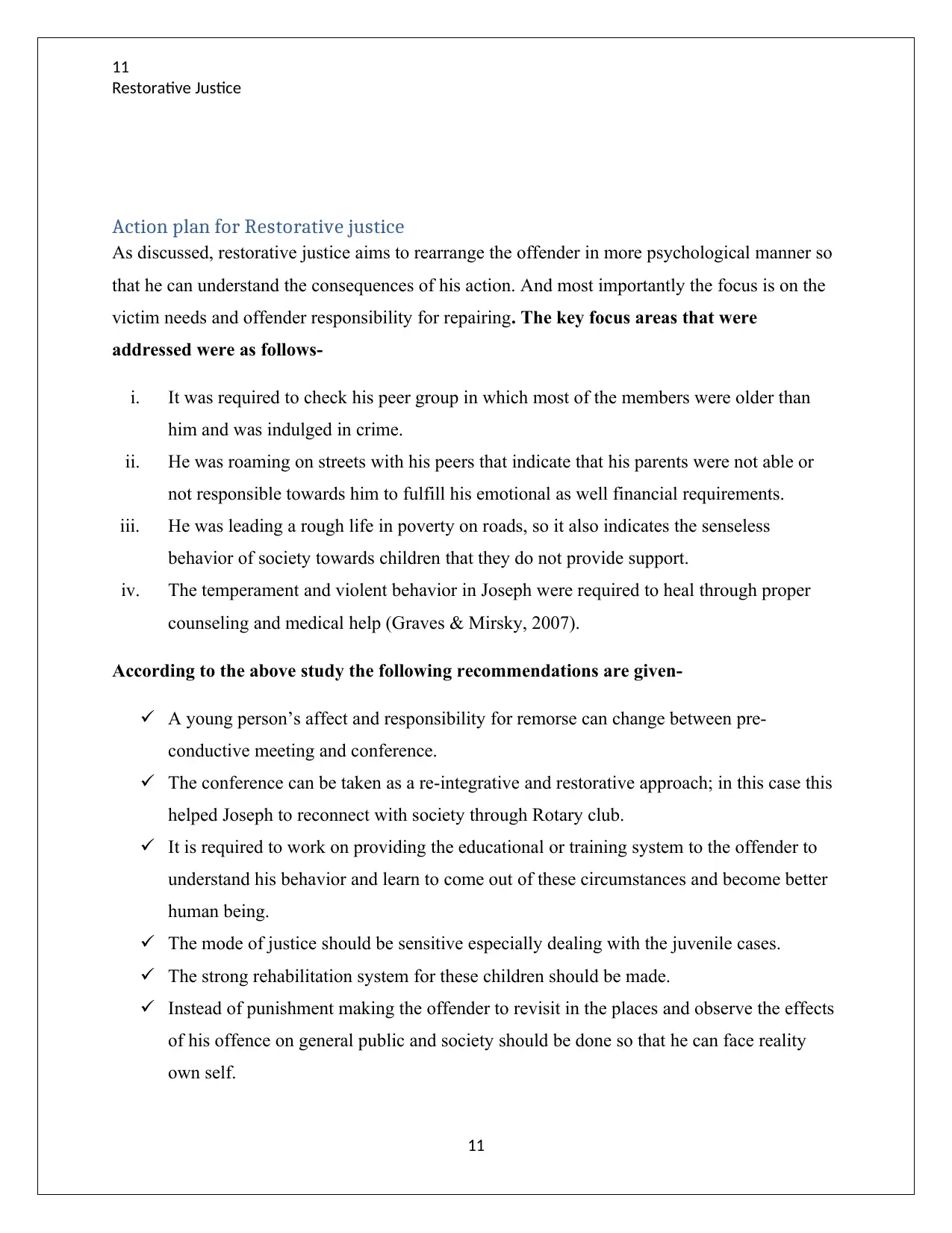
11
Restorative Justice
Action plan for Restorative justice
As discussed, restorative justice aims to rearrange the offender in more psychological manner so
that he can understand the consequences of his action. And most importantly the focus is on the
victim needs and offender responsibility for repairing. The key focus areas that were
addressed were as follows-
i. It was required to check his peer group in which most of the members were older than
him and was indulged in crime.
ii. He was roaming on streets with his peers that indicate that his parents were not able or
not responsible towards him to fulfill his emotional as well financial requirements.
iii. He was leading a rough life in poverty on roads, so it also indicates the senseless
behavior of society towards children that they do not provide support.
iv. The temperament and violent behavior in Joseph were required to heal through proper
counseling and medical help (Graves & Mirsky, 2007).
According to the above study the following recommendations are given-
A young person’s affect and responsibility for remorse can change between pre-
conductive meeting and conference.
The conference can be taken as a re-integrative and restorative approach; in this case this
helped Joseph to reconnect with society through Rotary club.
It is required to work on providing the educational or training system to the offender to
understand his behavior and learn to come out of these circumstances and become better
human being.
The mode of justice should be sensitive especially dealing with the juvenile cases.
The strong rehabilitation system for these children should be made.
Instead of punishment making the offender to revisit in the places and observe the effects
of his offence on general public and society should be done so that he can face reality
own self.
11
Restorative Justice
Action plan for Restorative justice
As discussed, restorative justice aims to rearrange the offender in more psychological manner so
that he can understand the consequences of his action. And most importantly the focus is on the
victim needs and offender responsibility for repairing. The key focus areas that were
addressed were as follows-
i. It was required to check his peer group in which most of the members were older than
him and was indulged in crime.
ii. He was roaming on streets with his peers that indicate that his parents were not able or
not responsible towards him to fulfill his emotional as well financial requirements.
iii. He was leading a rough life in poverty on roads, so it also indicates the senseless
behavior of society towards children that they do not provide support.
iv. The temperament and violent behavior in Joseph were required to heal through proper
counseling and medical help (Graves & Mirsky, 2007).
According to the above study the following recommendations are given-
A young person’s affect and responsibility for remorse can change between pre-
conductive meeting and conference.
The conference can be taken as a re-integrative and restorative approach; in this case this
helped Joseph to reconnect with society through Rotary club.
It is required to work on providing the educational or training system to the offender to
understand his behavior and learn to come out of these circumstances and become better
human being.
The mode of justice should be sensitive especially dealing with the juvenile cases.
The strong rehabilitation system for these children should be made.
Instead of punishment making the offender to revisit in the places and observe the effects
of his offence on general public and society should be done so that he can face reality
own self.
11
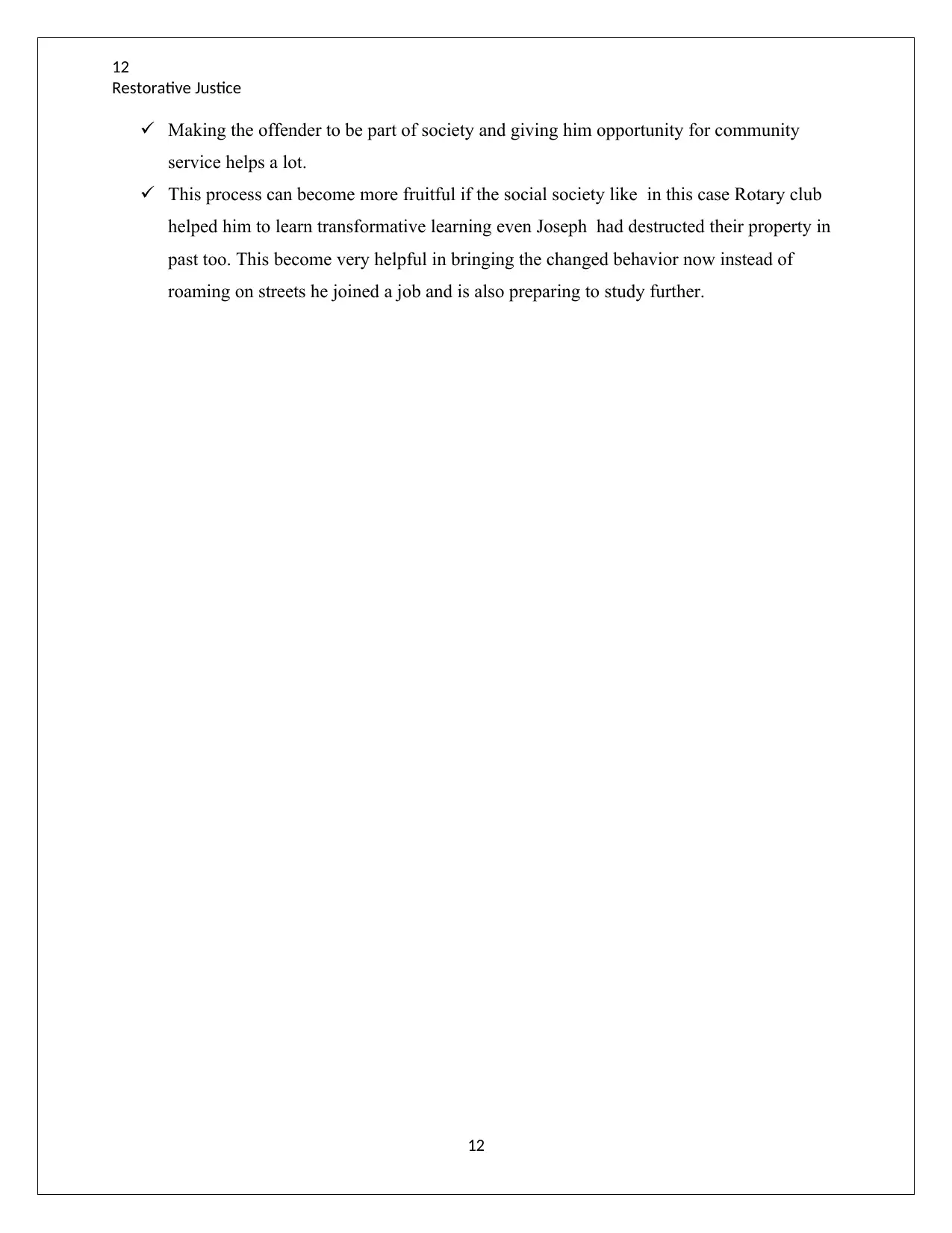
12
Restorative Justice
Making the offender to be part of society and giving him opportunity for community
service helps a lot.
This process can become more fruitful if the social society like in this case Rotary club
helped him to learn transformative learning even Joseph had destructed their property in
past too. This become very helpful in bringing the changed behavior now instead of
roaming on streets he joined a job and is also preparing to study further.
12
Restorative Justice
Making the offender to be part of society and giving him opportunity for community
service helps a lot.
This process can become more fruitful if the social society like in this case Rotary club
helped him to learn transformative learning even Joseph had destructed their property in
past too. This become very helpful in bringing the changed behavior now instead of
roaming on streets he joined a job and is also preparing to study further.
12
⊘ This is a preview!⊘
Do you want full access?
Subscribe today to unlock all pages.

Trusted by 1+ million students worldwide
1 out of 14
Related Documents
Your All-in-One AI-Powered Toolkit for Academic Success.
+13062052269
info@desklib.com
Available 24*7 on WhatsApp / Email
![[object Object]](/_next/static/media/star-bottom.7253800d.svg)
Unlock your academic potential
Copyright © 2020–2025 A2Z Services. All Rights Reserved. Developed and managed by ZUCOL.





